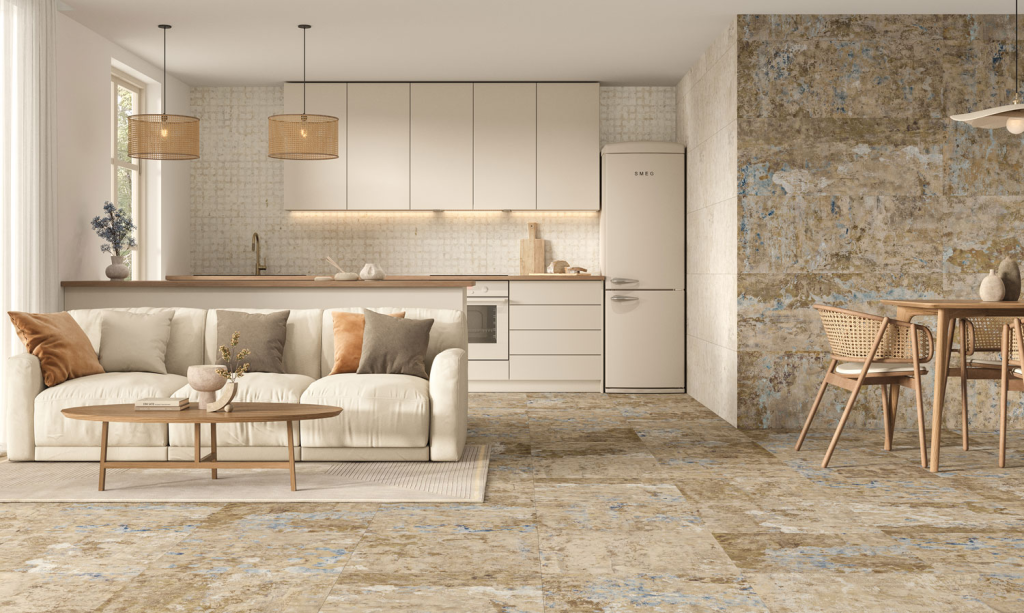porcelain vs ceramic tile

Cheap price of bedroom ceramics
Tiles are among the most popular materials for covering floors and walls. Among the various types available, Porcelain Tiles and Ceramic Tiles are the two most discussed options. Although both belong to the same family of clay-based products, they differ in structure, durability, and performance — differences that significantly influence the final choice
Composition and Manufacturing Process
Both porcelain and ceramic tiles are made from clay, minerals, and silica, but the main difference lies in density and firing temperature
Porcelain is made from finer, more refined clays (often called china clay) and fired at higher temperatures — around 1200–1400°C. This process produces a denser, harder, and more impervious surface
Ceramic tiles, on the other hand, are fired at lower temperatures. Their raw materials are generally less refined, making them slightly more porous and lighter in weight. As a result, ceramics are easier to cut and install but less resistant to heavy wear or impact
Water Resistance and Durability
Thanks to its density and water absorption rate below 0.5%, porcelain is ideal for humid areas such as bathrooms, kitchens, balconies, and even outdoor spaces. This low absorption rate prevents stains, moisture damage, and frost cracking
Ceramic, by contrast, typically absorbs 3–5% of water. This makes it more suitable for dry indoor areas like bedrooms or living room walls, where exposure to moisture is minimal
Strength and Longevity
In terms of durability, porcelain is the clear winner. Its dense, solid structure makes it highly resistant to scratching, pressure, and wear, which is why it’s widely used in high-traffic areas such as hallways, malls, and commercial spaces
Ceramic, due to its slightly porous structure, is more brittle and better suited for low-traffic or decorative areas
Installation and Cost
Porcelain tiles are harder and denser, making them more difficult to cut and install. Specialized tools are required, which increases labor costs slightly. Their heavier weight also adds to the transportation and handling challenge
Ceramic tiles, in contrast, are lighter, easier to work with, and more affordable. This makes them a great option for DIY projects or budget-friendly home renovations.
Appearance and Design Possibilities
Both porcelain and ceramic tiles now come in a variety of designs, colors, and textures, thanks to advanced digital printing technology. They can realistically imitate the look of natural stone, wood, or even concrete
However, porcelain tiles are often available in through-body designs, meaning that the color and pattern run throughout the tile’s thickness, not just on the surface. This feature ensures that minor chips or scratches are less noticeable over time
Ceramic tiles usually have a glazed surface, so if chipped, the underlying clay color may become visible
Use in Interior and Exterior Design
In luxury or commercial projects, porcelain is a preferred choice because of its refined look, exceptional hardness, and low maintenance requirements
For interior residential spaces such as kitchen walls or bathrooms, ceramic tiles remain a popular and cost-effective option
When it comes to outdoor installations or cold climates, frost-resistant porcelain is highly recommended, as ceramic may crack under freezing conditions
Final Comparison
In summary, porcelain stands out as a more durable, water-resistant, and professional-grade material — but it comes with a higher cost. Ceramic, meanwhile, offers a lighter, more budget-friendly, and easier-to-install alternative for indoor areas
If strength and moisture resistance are your priorities, porcelain is the safer, long-term investment. But if you’re working within a limited budget and the tiles will be installed in a dry indoor space, ceramic tiles offer an attractive and practical solution
Price of porcelain ceramic patio
The Allure of Black Ceramic Facades

















